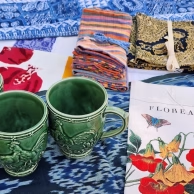 Sat./Sun. Nov. 8 & 9
Sat./Sun. Nov. 8 & 9
9:30am to 3:00 pm
Not to be Missed!
Find artisan jewelry, stylish shoes, clothing and accessories, local artisan and other special art and craft pieces, antiques, linens, kitchen stuff, CDs, books.
You never know what you’ll discover from Eve’s personal collection! Eve has spent her life as a treasure hunter, seeking beauty, quality, authenticity and value, in every realm, from experiences to plants to art to earrings! Bring your friends!
CASH ONLY![Read More]

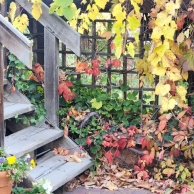 I confess. I am definitely a plant hoarder. Every year, I amass a formidable collection of plant starts, and then spend evenings through the season walking around my garden, little pots in hand, trying to find a few square inches where I can fit them in. Then I make tags and put them in the spots I’ve found (or created by taking some other plant out). If the critters don’t pull them out, most of those tags wait months for the magical moment when the weather is mild enough for me to plant them – October at last!
I confess. I am definitely a plant hoarder. Every year, I amass a formidable collection of plant starts, and then spend evenings through the season walking around my garden, little pots in hand, trying to find a few square inches where I can fit them in. Then I make tags and put them in the spots I’ve found (or created by taking some other plant out). If the critters don’t pull them out, most of those tags wait months for the magical moment when the weather is mild enough for me to plant them – October at last!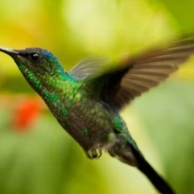 All summer and fall, Mikl and I have been collecting seeds from our own gardens and from wildlands where we have collecting permits, and at this point, most of that collecting is done. After spending last Sunday cataloging our seed collections, I’m delighted to report that so far, we have collected at least 85 species, most of them local natives. We can’t sell you the seeds we collect (the USDA won’t allow it), and besides, we need them for growing our plants for you. But we have excellent wildflower seed mixes from BBB Seeds in Boulder.
All summer and fall, Mikl and I have been collecting seeds from our own gardens and from wildlands where we have collecting permits, and at this point, most of that collecting is done. After spending last Sunday cataloging our seed collections, I’m delighted to report that so far, we have collected at least 85 species, most of them local natives. We can’t sell you the seeds we collect (the USDA won’t allow it), and besides, we need them for growing our plants for you. But we have excellent wildflower seed mixes from BBB Seeds in Boulder.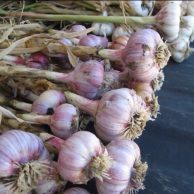 I’ve been shopping at my local Farmers Market on Saturday mornings, and have been really impressed with some of the gorgeous, large vegetables some of my favorite farms have grown this year. Most notable were the huge fennel bulbs and the stunning, large, firm heads of purple radicchio. But the garlic bulbs I found at the market have been, to be blunt, puny. And most are sold without variety names. Some were not properly cured. Small bulbs with small cloves are just fine for use in the kitchen for the next 3 to 5 months, but they are not suitable for planting.
I’ve been shopping at my local Farmers Market on Saturday mornings, and have been really impressed with some of the gorgeous, large vegetables some of my favorite farms have grown this year. Most notable were the huge fennel bulbs and the stunning, large, firm heads of purple radicchio. But the garlic bulbs I found at the market have been, to be blunt, puny. And most are sold without variety names. Some were not properly cured. Small bulbs with small cloves are just fine for use in the kitchen for the next 3 to 5 months, but they are not suitable for planting. 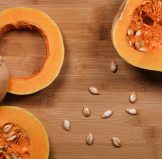
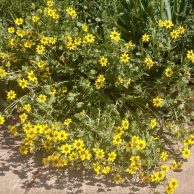


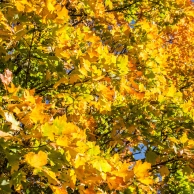
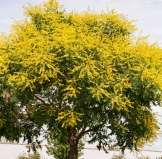
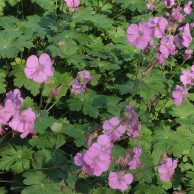
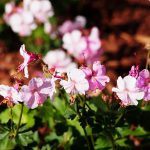
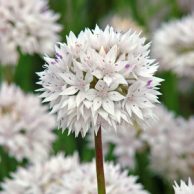
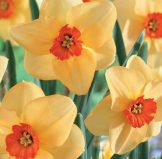
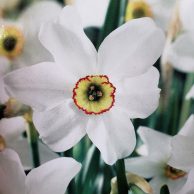
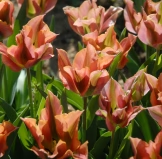 Our staff have been restocking bulbs, and a few favorites have emerged! Mid–October to mid-November is the right time to plant them. Come in this weekend as they’re going fast! We have a curated collection of flowering Allium, Narcissus (daffodils), Crocus, Tulips, and more!
Our staff have been restocking bulbs, and a few favorites have emerged! Mid–October to mid-November is the right time to plant them. Come in this weekend as they’re going fast! We have a curated collection of flowering Allium, Narcissus (daffodils), Crocus, Tulips, and more!

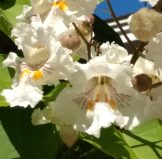

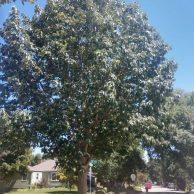


 By Eve Reshetnik Brawner
By Eve Reshetnik Brawner A cornucopia of stunning, hardy bulbs will be arriving in August and early September at Harlequin’s, so get ready! Now is a great time to peruse our list (at the link below) and to look at your garden to identify areas where you can add fall-planted bulbs for (mostly) spring blooms (a few special Crocus and Colchicum bloom later in the fall!). Consider the gentle drama of a drift of mixed daffodils (Narcissus) that bloom from early to late spring
A cornucopia of stunning, hardy bulbs will be arriving in August and early September at Harlequin’s, so get ready! Now is a great time to peruse our list (at the link below) and to look at your garden to identify areas where you can add fall-planted bulbs for (mostly) spring blooms (a few special Crocus and Colchicum bloom later in the fall!). Consider the gentle drama of a drift of mixed daffodils (Narcissus) that bloom from early to late spring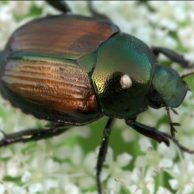






 On Monday, we had the great pleasure and honor of receiving a busload of several dozen public garden professionals from American Public Garden Association member institutions around the US and Canada. They represented prestigious arboretums and public gardens like the historic Vizcaya estate in Miami FL and Lotusland in Santa Barbara CA, and gardens from Guelph to Pennsylvania to Phoenix. . They had come to Denver for APGA’s annual conference, which began with for a tour of public gardens, hosted by Denver Botanic Gardens’ senior curator and director of outreach, Panayoti Kelaidis. Panayoti arranged a brilliant itinerary, including both the Hardy Roses Demonstration Garden at the Boulder Dushanbe Teahouse, and Harlequin’s Gardens Nursery!
On Monday, we had the great pleasure and honor of receiving a busload of several dozen public garden professionals from American Public Garden Association member institutions around the US and Canada. They represented prestigious arboretums and public gardens like the historic Vizcaya estate in Miami FL and Lotusland in Santa Barbara CA, and gardens from Guelph to Pennsylvania to Phoenix. . They had come to Denver for APGA’s annual conference, which began with for a tour of public gardens, hosted by Denver Botanic Gardens’ senior curator and director of outreach, Panayoti Kelaidis. Panayoti arranged a brilliant itinerary, including both the Hardy Roses Demonstration Garden at the Boulder Dushanbe Teahouse, and Harlequin’s Gardens Nursery! I’ve often talked to you about native and water-wise plants, but I am still referred to as ‘the Rose Lady’ at Harlequin’s. I still love roses, and still grow some choice favorites for their fragrance, beauty and ease. Some of them have been in my garden far longer than I have – Banshee and Desiree Parmentier, and a few others that are particularly fragrant thrive and require with little care – Darlow’s Enigma, Stanwell Perpetual, Scotsbriar, Sharifa Asma and The Prince. They are all on their own roots – not grafted – and that’s a big reason they are still alive, robust and beautiful!
I’ve often talked to you about native and water-wise plants, but I am still referred to as ‘the Rose Lady’ at Harlequin’s. I still love roses, and still grow some choice favorites for their fragrance, beauty and ease. Some of them have been in my garden far longer than I have – Banshee and Desiree Parmentier, and a few others that are particularly fragrant thrive and require with little care – Darlow’s Enigma, Stanwell Perpetual, Scotsbriar, Sharifa Asma and The Prince. They are all on their own roots – not grafted – and that’s a big reason they are still alive, robust and beautiful! Spring rains have awakened a wonderful show of wildflowers on the Front Range this year. And along with all the smaller species, we see that our local Yucca glauca is having a boom bloom year. The flower stalks are pushing upward and will soon be blooming profusely, looking like big white candles dotting the landscape. The large bell-shaped, lily-like, fragrant flowers are creamy white to pale green and hang downward from a central stalk. They have thick, waxy petals that conserve moisture for a long bloom time.
Spring rains have awakened a wonderful show of wildflowers on the Front Range this year. And along with all the smaller species, we see that our local Yucca glauca is having a boom bloom year. The flower stalks are pushing upward and will soon be blooming profusely, looking like big white candles dotting the landscape. The large bell-shaped, lily-like, fragrant flowers are creamy white to pale green and hang downward from a central stalk. They have thick, waxy petals that conserve moisture for a long bloom time. The gardening movement that places soil health at the center of plant health has been where Harlequin’s Gardens has experimented, succeeded and educated for the past 33 years.
The gardening movement that places soil health at the center of plant health has been where Harlequin’s Gardens has experimented, succeeded and educated for the past 33 years. Solidago ptarmicoides
Solidago ptarmicoides Just because it’s July doesn’t mean vegetable planting season is over! This is the month to ensure an abundant fall harvest.
Just because it’s July doesn’t mean vegetable planting season is over! This is the month to ensure an abundant fall harvest. This season’s early rains, followed by heat, have resulted in an herbal harvest bonanza! If you’re finding you have more herbs than you can use fresh, here are four easy ways to taste a bit of summer freshness all year round. We’re saving dill, basil, cilantro, parsley, oregano, lemon balm and mint this month!
This season’s early rains, followed by heat, have resulted in an herbal harvest bonanza! If you’re finding you have more herbs than you can use fresh, here are four easy ways to taste a bit of summer freshness all year round. We’re saving dill, basil, cilantro, parsley, oregano, lemon balm and mint this month!


 So many very special experiences!
So many very special experiences!  When we garden with a mission of sustainability, driven by our conviction that plant (and all) life depends on vibrant soil health, we don’t always realize that we’re part of an alternative lineage grounded in an understanding that everything is deeply connected.
When we garden with a mission of sustainability, driven by our conviction that plant (and all) life depends on vibrant soil health, we don’t always realize that we’re part of an alternative lineage grounded in an understanding that everything is deeply connected. This is your best chance for big savings on healthy, highly desirable, container-grown trees that are very successful in our challenging Colorado conditions! We grew these healthy ‘seconds’ ourselves since they were little babies, in our own soil formulas and without any chemicals, in #5 (5-gallon) pots and larger. The only difference between these and their full-price counterparts is that the sale plants are a little shorter or slightly less full.
This is your best chance for big savings on healthy, highly desirable, container-grown trees that are very successful in our challenging Colorado conditions! We grew these healthy ‘seconds’ ourselves since they were little babies, in our own soil formulas and without any chemicals, in #5 (5-gallon) pots and larger. The only difference between these and their full-price counterparts is that the sale plants are a little shorter or slightly less full. Rosa nutkana
Rosa nutkana I recently attended a public conversation on the subject of ‘Avant Gardening’ at the Longmont Museum. Host Emily Maeda, co-owner of Tree of Life Landscaping, conversed with accomplished front range horticulturists and landscape designers Bryan Fischer and Kevin Phillip Williams about what constitutes the current avant-garde in gardening. I didn’t really feel that their discussion was conclusive, but the question has been in my thoughts. I now realize that in my mind, the definitive answer is habitat gardening.
I recently attended a public conversation on the subject of ‘Avant Gardening’ at the Longmont Museum. Host Emily Maeda, co-owner of Tree of Life Landscaping, conversed with accomplished front range horticulturists and landscape designers Bryan Fischer and Kevin Phillip Williams about what constitutes the current avant-garde in gardening. I didn’t really feel that their discussion was conclusive, but the question has been in my thoughts. I now realize that in my mind, the definitive answer is habitat gardening.
 We are grateful to have one day to acknowledge the value of the Earth. Wendell Berry said, “Earth is what we all have in common.” Pope Francis said we all have a shared responsibility for protecting the Earth, our common home, and he urged us to care for the environment. It’s pretty obvious, isn’t it?
We are grateful to have one day to acknowledge the value of the Earth. Wendell Berry said, “Earth is what we all have in common.” Pope Francis said we all have a shared responsibility for protecting the Earth, our common home, and he urged us to care for the environment. It’s pretty obvious, isn’t it?
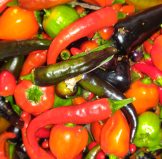 PEPPER
PEPPER

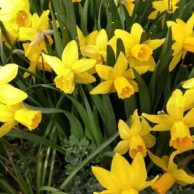

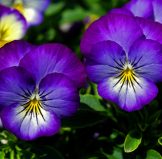
 Townsendia hookeri, pictured above, is already supporting butterflies! Also known as the Easter Daisy, it blooms for a long time – often through May. This Rocky Mountain native is drought-tolerant, is found in gravelly areas and grasslands, can withstand freezing conditions and snow, and thrives in crevice gardens. This particular one bloomed this weekend in Eve’s garden in Longmont!
Townsendia hookeri, pictured above, is already supporting butterflies! Also known as the Easter Daisy, it blooms for a long time – often through May. This Rocky Mountain native is drought-tolerant, is found in gravelly areas and grasslands, can withstand freezing conditions and snow, and thrives in crevice gardens. This particular one bloomed this weekend in Eve’s garden in Longmont!